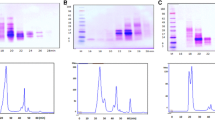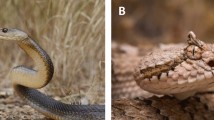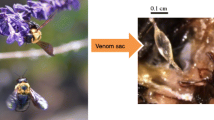Abstract
The biochemical properties and biological activities of the venom from three individual Ophiophagus hannah (King cobra) specimens was compared. The toxicity against mice, the cytotoxicity against five cell lines, and the antioxidant activity were measured. The KV2 venom showed a higher cytotoxicity than the KV6 and the non-cytotoxic KV9 venoms. Comparative analysis of the O. hannah venom proteins was performed after 2-dimensional (2-D) denaturing gel electrophoresis and reverse phase high performance liquid chromatography (RP-HPLC). 2-D analysis by isoelectric focusing (IEF) Sodium dodecyl sulfate polyacrylamide gel electrophoresis (SDS-PAGE) resolution of the venoms revealed significant differences between all three venoms, with most spots being unique to that venom. Only 2 out of the 13–16 distinct spots were common to all three venoms, and four spots were common to KV6 and KV9. KV2 had the highest proportion of low molecular mass spots, and KV6 and KV9 appeared more related to each other than to KV9. From peptide mass mapping by matrix assisted laser desorption ionization-time of flight mass spectrometry (MALDI-TOF MS) and MASCOT-based amino acid sequence database searching, the two venom proteins that were common to all three specimens are likely to be ophanin and acidic phospholipase A2 (PLA2), whilst the proteins unique to the cytotoxic KV2 venom, included three other PLA2 proteins. The RP-HPLC pattern of KV2 was different from the other two venoms with a higher protein concentration eluting in the 31–41% (v/v) acetonitrile (ACN) fraction than for the other two venoms.








Similar content being viewed by others
References
Chan YS, Cheung RC, Xia L, Wong JH, Ng TB, Chan WY (2016) Snake venom toxins: toxicity and medicinal applications. Appl Microbiol Biotechnol 100:6165–6181
He YY, Lee WH, Zhang Y (2004) Cloning and purification of α-neurotoxins from king cobra (Ophiophagus hannah). Toxicon 44:295–303
Rajagopalan N, Pung YF, Zhu YZ, Wong PT, Kumar PP, Kini RM (2007) Beta-cardiotoxin: a new three-finger toxin from Ophiophagus hannah (king cobra) venom with beta-blocker activity. FASEB J 21:3685–3695
Li J, Zhang H, Liu J, Xu K (2006) Novel genes encoding six kinds of three finger toxins in Ophiophagus hannah (king cobra) and function characterization of two recombinant long-chain neurotoxins. Biochem J 398:233–242
Danpaiboon W, Reamtong O, Sookrung N, Seesuay W, Sakolvaree Y, Thanongsaksrikul J, Dong-din-on F, Srimanote P, Thueng-in K, Chaicumpa W (2014) Ophiophagus hannah venom: proteome, components bound by Naja kaouthia antivenin and neutralization by N. kaouthia neurotoxin-specific human ScFv. Toxins (Basel) 13:1526–1558
Huang MZ, Gopalakrishnakone P, Chung MCM, Kini RM (1997) Complete amino acid sequence of an acidic, cardiotoxic phospholipase A2 from the venom of Ophiophagus hannah (King Cobra): a novel cobra venom enzyme with “pancreatic loop”. Arch Biochem Biophys 338:150–156
Kini RM (2003) Excitement ahead: structure, function and mechanism of snake venom phospholipase A2 enzymes. Toxicon 42:827–840
Kini RM (2005) The intriguing world of prothrombin activators from snake venom. Toxicon 45:1133–1145
Yamazaki Y, Hyodo F, Morita T (2003) Wide distribution of cysteine-rich secretory proteins in snake venoms: isolation and cloning of novel snake venom cysteine-rich secretory proteins. Arch Biochem Biophys 412:133–141
Petras D, Heiss P, Süssmuth RD, Calvete JJ (2015) Venom proteomics of Indonesian King Cobra, Ophiophagus hannah: integrating top-down and bottom-up approaches. J Proteome Res 14:2539–2556
Chang LS, Chung C, Huang HB, Lin SR (2001) Purification and characterization of a chymotrypsin inhibitor from the venom of Ophiophagus hannah (King Cobra). Biochem Biophys Res Commun 283:862–867
Du XY, Clemetson KJ (2002) Snake venom L-amino acid oxidases. Toxicon 40:659–665
Costa TR, Burin SM, Menaldo DL, de Castro FA, Sampaio SV (2014) Snake venom L-amino acid oxidases: an overview on their antitumor effects. J Venom Anim Toxins Incl Trop Dis 20:23
Pung YF, Wong PTH, Kumar PP, Hodgson WC, Kini RM (2006) Ohanin, a novel protein from king cobra venom, induces hypolocomotion and hyperalgesia in mice. J Biol Chem 280:13137–13147
Suntrarachun S, Chanhome L, Sumontha M (2014) Phylogenetic analysis of the king cobra, Ophiophagus hannah in Thailand based on mitochondrial DNA sequences. Asian Biomed 8:269–274
Tan CH, Tan KY, Fung SY, Tan NH (2015) Venom-gland transcriptome and venom proteome of the Malaysian king cobra (Ophiophagus hannah). BMC Genomics 16:687
Bradford MM (1976) A rapid and sensitive method for the quantitation of microgram quantities of protein utilizing the principle of protein-dye binding. Anal Biochem 72:248–254
Berkelman T, Stenstedt T (1998) 2-D electrophoresis using immobilized pH gradients. Principles and methods. Amersham Pharmacia Biotech Inc, Uppsala
Garfin DE (2009) One-dimensional gel electrophoresis. Methods Enzymol 463:497–513
Shevchenko A, Sunyaev S, Loboda A, Bork P, Ens W (2001) Charting the proteomes of organisms with unsequenced genomes by MALDI-quadrupole time-of-flight mass spectrometry and BLAST homology searching. Anal Chem 73:1917–1926
Tanzadehpanah H, Asoodeh A, Chamani J (2012) An antioxidant peptide derived from ostrich (Struthio camelus) egg white protein hydrolysates. Food Res Int 49:105–111
Pérez JM, Maldonado ME, Rojano BA, Alzate F, Sáez J, Cardona W (2014) Comparative antioxidant, antiproliferative and apoptotic effects of Ilex laurina and Ilex paraguariensis on colon cancer cells. Trop J Pharm Res 13:1279–1286
Ahn MY, Lee BM, Kim YS (1997) Characterization and cytotoxicity of L amino acid oxidase from the venom of king cobra (Ophiophagus hannah). Int J Biochem Cell Biol 29:911–919
Chiou JY, Chang LS, Chen LN, Chang CC (1995) Purification and characterization of a novel phospholipase A2 from king cobra (Ophiophagus hannah) venom. J Protein Chem 14:451–456
Acknowledgements
We acknowledge the financial support from the Grant for Research: Government Budget, Chulalongkorn University under grant number of GB-B_61_096_61_02, and the Center of Excellence on Medical Biotechnology (CEMB), S&T Postgraduate Education and Research Development Office (PERDO), Office of Higher Education Commission (OHEC), Thailand (SN-60-003-909), and the Institute of Biotechnology and Genetic Engineering and Biotechnology program, the Faculty of Science, Chulalongkorn University, for support and facilities. We also thank Dr. Robert Butcher (Publication Counseling Unit, Chulalongkorn University) for his constructive comments in preparing this manuscript. Dr. Victoria Muir from Edanz Group (www.edanzediting.com/ac) edited a draft of this manuscript.
Author information
Authors and Affiliations
Corresponding author
Additional information
Publisher's Note
Springer Nature remains neutral with regard to jurisdictional claims in published maps and institutional affiliations.
Rights and permissions
About this article
Cite this article
Wongtay, P., Sangtanoo, P., Sangvanich, P. et al. Variation in the Protein Composition and Biological Activity of King Cobra (Ophiophagus hannah) Venoms. Protein J 38, 565–575 (2019). https://doi.org/10.1007/s10930-019-09852-5
Published:
Issue Date:
DOI: https://doi.org/10.1007/s10930-019-09852-5




